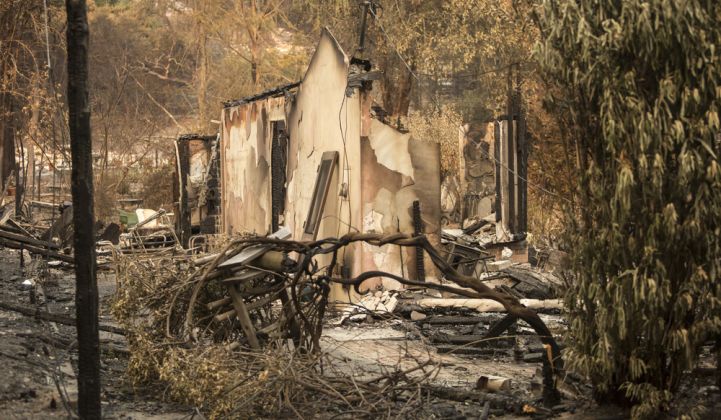When Stone Edge Farm Estate Vineyards & Winery looked to build out a new property in the Mayacamas Mountains straddling Napa and Sonoma counties, the owners found themselves in a multimillion-dollar quandary.
The secluded spot made it an excellent site for a vineyard, but it would cost Pacific Gas & Electric a lot of money to run the 480-volt 3-phase power lines to the property to run the necessary winery equipment. In order to make it work, Mac and Leslie McQuown had to find a more economical way.
Stone Edge isn’t the typical farm. It’s a 16-acre property that uses 10 different kinds of inverters, a fuel-cell “hive,” and seven battery systems, with another on the way. The property was recently in the news for its microgrid system that held up during the devastating fires in Northern California. In January, the microgrid project won a Governor’s Environmental and Economic Leadership Award from the state of California.
The plan to bring power to Stone Edge’s remote vineyard has become another test case for off-grid technology: the Silver Cloud microgrid project. This time, unlike at the original Stone Edge site, there will be no grid backup.
“In the case of Silver Cloud, if the design is not robust enough, we have no failsafe,” said Craig Wooster, general contractor and project manager for the Stone Edge Microgrid Project and CEO of Wooster Energy Engineering. “We’ve got to be able to stand alone.”
Wooster took lessons from the “living laboratory” that is the Stone Edge farm and built out a design for the Silver Cloud microgrid that also incorporates learnings from the fires.
Eventually, Stone Edge and Silver Cloud will join up with future microgrids to create an “aggregation of assets” on five of seven Stone Edge properties.
“Our ultimate goal is to figure out how to replicate microgrids economically and quickly,” said Wooster.
Efforts to reach that goal could benefit Californians outside of the upscale farm and winery, as fierce wildfires become increasingly common due to climate change. The Stone Edge microgrid ran islanded for 10 days while areas around it experienced power outages and thousands of homes burned to the ground.
And though Stone Edge kept going -- its evacuated staff operated the microgrid remotely -- Wooster has also identified about “two dozen takeaways” and ways to improve resilience and functionality that will come into play at the second site.
Silver Cloud will incorporate about 300 kilowatts of solar power, eight Ideal Power converters and a SimpliPhi Power battery system to make up a 480-volt AC grid with a capacity of at least 240 kilowatts. Wooster said the system could go up to 400 kilowatts, and he often evolves his designs over time.
“One of the prospects of working with Stone Edge -- and what I love -- is that any project, as we work through the different stages from design to execution, changes depending on the dynamic needs of the vineyard,” said Catherine Von Burg, president and CEO at SimpliPhi.
The original Stone Edge site incorporates Ideal converters and several SimpliPhi battery units. But the set-up planned for Silver Cloud ensures that if one converter goes down, there is no single point of failure.
“There’s a level of redundancy there that you can’t get with other brands of converters,” said John Merritt, director of applications engineering at Ideal Power. “It’s a cleaner-running system, it’s a simpler system, and it’s a more robust and redundant system.”
The lithium-ferro-phosphate SimpliPhi batteries can’t catch on fire like other lithium-ion batteries. And here, as Von Burg put it, “chemistry matters.”
Wooster said selecting the SimpliPhi battery for the new site was a “no-brainer.”
“What we learned in the fire is you don’t want to put something out there that could either be ignited by a wildfire or be the source of a wildfire,” he said.
And according to Wooster, though the farm has been diligent in tree-trimming, it also learned it has to be “a lot more aggressive” in land management. Silver Cloud will grind woody debris into chips and use that as fuel to produce electricity.
During the fires, Wooster also noted that the solar array remained at 50 percent of normal production, in spite of the smoke and ash. The farm had to take out some of its solar, because it usually uses excess production to create hydrogen -- which is highly flammable -- to power the farm’s cars. Now, the farm is working with Enphase Energy to engineer a system that offers more control on individual panels.
“Like the knob on your radio that you increase the volume with, we’ll be able to turn it up or down,” said Wooster. “That's a huge, huge breakthrough for the world of microgrids. [...] Before the fire we had never considered curtailing solar.”
The Silver Cloud project should be up and running by July, Wooster said. Farm staff is also pondering how these innovations can provide examples beyond the seven properties.
Wooster said he and Mac McQuown have discussed the possibilities of bringing back areas like Coffey Park in Santa Rosa, California, which the Tubbs fire razed, with low-energy and resilient buildings. On Friday, Wooster will speak in Santa Rosa at the Rebuild Green Expo, an event focused on sustainable rebuilding construction for the areas impacted by fire.
“I’m being sent to talk about microgrids,” he said. “But the reality is, let’s think of something far bigger: A community that is destroyed that could be rebuilt with an autonomous power system. It could actually have its own fueling stations for hydrogen-powered cars, electric vehicles -- what does the future look like?”
--
Grid Edge Innovation Summit is the leading future energy conference that will examine the energy customer of tomorrow and how new innovative business models are quickly emerging. Join us as we bring together the most forward thinking and prominent members of the energy ecosystem and as our research team explores the future of the market.




